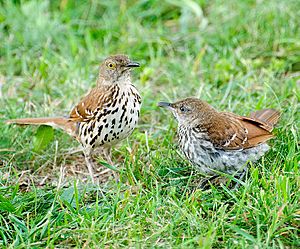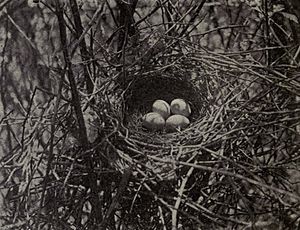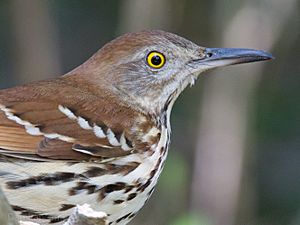Brown thrasher facts for kids
Quick facts for kids Brown thrasher |
|
|---|---|
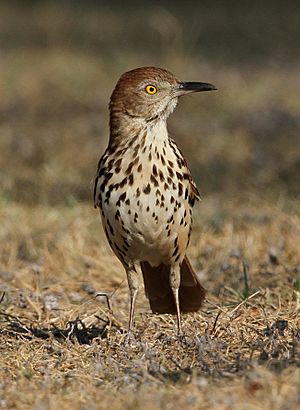 |
|
| In Texas, U.S. | |
| Conservation status | |
| Scientific classification | |
| Genus: |
Toxostoma
|
| Species: |
rufum
|
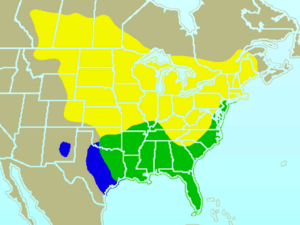 |
|
| Range of T. rufum Breeding range Year-round range Wintering range | |
| Synonyms | |
|
|
The brown thrasher (Toxostoma rufum) is a cool bird that belongs to the Mimidae family. This family also includes catbirds and mockingbirds. Brown thrashers are very common in the eastern and central United States and southern and central Canada. They are the only thrasher bird that mostly lives east of the Rocky Mountains and central Texas. It's even the state bird of Georgia!
As a member of the Toxostoma group, the brown thrasher is one of the bigger thrasher birds. It has a brown back and a white belly with dark stripes. Because of this, people sometimes confuse it with the smaller wood thrush (Hylocichla mustelina). The brown thrasher is famous for its amazing singing. It can sing over 1,000 different types of songs, which is the largest song collection of any bird! However, it usually repeats each part of its song two or three times.
Brown thrashers eat both plants and animals, like insects, fruits, and nuts. They usually build their nests in bushes, small trees, or sometimes even on the ground. These birds are usually shy, but they are very protective of their nests. They will even attack animals as big as humans if they feel their nest is in danger!
Contents
About the Brown Thrasher
The brown thrasher was first described by Carl Linnaeus in 1758. The name Toxostoma comes from ancient Greek words meaning "bow" or "arch" and "mouth," referring to its curved beak. The word rufum is Latin for "red."
Even though it's not a thrush, some people mistakenly call it the brown thrush. This might be because the word "thrasher" sounds a bit like "thrush." Early naturalists sometimes called it the "fox-coloured thrush."
Scientists have studied the genes of the brown thrasher. They found that it is most closely related to the long-billed and Cozumel thrashers. These birds are all part of the Toxostoma group.
What Does a Brown Thrasher Look Like?
The brown thrasher has a bright reddish-brown back. Its belly is a light yellowish-white with thin, dark stripes. It has a white chest with clear, tear-shaped spots. Its long, reddish-brown tail is rounded with lighter corners, and its eyes are a bright yellow. Its beak is brownish, long, and curves downwards. Both male and female brown thrashers look similar. Young thrashers look a lot like adults, but their feathers might feel a bit different, and their eyes are more olive-colored.
The brown thrasher is a medium-sized bird. Adults are about 23.5 to 30.5 centimeters (9 to 12 inches) long. Their wingspan is about 29 to 33 centimeters (11 to 13 inches). They usually weigh between 61 to 89 grams (2.1 to 3.1 ounces).
There are two types, or subspecies, of brown thrashers:
- The 'brown thrasher' (T. rufum rufum) lives in the eastern parts of Canada and the United States.
- The 'western brown thrasher' (T. rufum longicauda) lives in the central United States, east of the Rocky Mountains, and in southern central Canada. The western type has a more cinnamon-colored back, whiter wing bars, and darker spots on its chest.
The lifespan of a brown thrasher can vary. About 35% survive their first year. This goes up to 50% between their second and third year, and 75% between their third and fourth year. Cold weather and diseases can limit how long they live. The oldest known brown thrasher in the wild lived for 12 years. Birds in captivity can live about the same amount of time.
Similar Birds
The long-billed thrasher looks similar but lives in a much smaller area. It has a gray head and neck, and a longer beak than the brown thrasher. The brown thrasher also looks a lot like the wood thrush, which it is often mistaken for. However, the wood thrush has dark spots on its belly instead of streaks. It also has dark eyes, a shorter tail, and a shorter, straighter beak. The wood thrush is also a smaller bird.
Where Brown Thrashers Live
Brown thrashers live in many different places. They like to be near the edges of woodlands, in thick bushes, and dense shrubs. They often look for food among dry leaves on the ground. They can also live in farm areas and near towns, but they usually stay away from houses more than other birds. Brown thrashers often compete with other birds for good places to live and build nests.
The brown thrasher is a strong migrant, but not all of them move. Birds in the southern parts of their range stay there all year. The breeding areas include the United States and Canada, east of the Rocky Mountains. Sometimes, they are seen west of the Rockies too. More trees growing in the Great Plains over the last century have helped brown thrashers spread further west.
When they do migrate, they usually travel short distances at night. Birds from New England fly to the Carolinas and Georgia for winter. Birds from east of the Mississippi River winter from Arkansas to Georgia. Those from the Dakotas and central Canada go to eastern Texas and Louisiana. There have even been records of them wintering in Mexico and one bird was seen in Great Britain after flying across the Atlantic Ocean!
Brown Thrasher Behavior
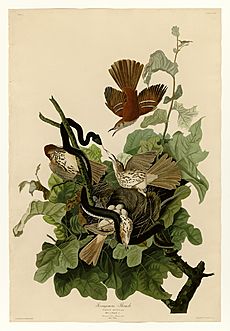
Brown thrashers are usually seen alone or in pairs. They are often shy and fly close to the ground to stay hidden. If they feel bothered, they will hide in thick bushes and make cackling sounds. Thrashers spend most of their time on or near the ground. When you do see them, it's often the males singing from open branches.
Brown thrashers are known for being aggressive, especially when defending their nests. However, their name doesn't come from attacking threats. It's believed to come from the "thrashing" sound they make when digging through leaves on the ground. Some also think it comes from the thrashing sound they make when smashing large insects to eat them.
What Brown Thrashers Eat
Brown thrashers are omnivores, meaning they eat both plants and animals. Their diet includes insects, berries, nuts, seeds, earthworms, snails, and sometimes even small lizards and frogs.
During the breeding season, they mostly eat beetles, grasshoppers, and other bugs. They also eat fruits, nuts, and seeds. In Illinois, over 80% of their diet is animal matter, with about half being beetles. In Iowa, about 20% of their summer diet is grasshoppers.
By late summer, they start eating more plants, focusing on fruits, nuts, seeds, and grains. In Illinois, 60% of their food becomes fruits and seeds. In winter, they mostly eat fruit and acorns. Birds wintering in Texas ate mostly plants (like sugar berries and poison ivy) in October. But by March, when food is harder to find, 80% of their diet became animal matter. They only sometimes eat small animals like reptiles and amphibians, such as lizards, small snakes, tree frogs, and salamanders.
Brown thrashers use their excellent eyesight to find food. They usually search for food under leaves, bushes, and dirt on the ground using their beak. They swipe the ground from side to side and then check the area they just searched. They can also crack open nuts like acorns by hammering them. They are very flexible and can catch fast insects because they have more bones in their neck than giraffes or camels! One thrasher was even seen digging a small hole, putting an acorn in it, and hitting it until it cracked. This is a type of tool use!
How Brown Thrashers Breed
Brown thrashers usually have one mate, but sometimes they might switch partners, even in the same season. Their breeding season changes depending on where they live. In the southeastern United States, breeding starts in February and March. In the northern parts of their range, it begins in May and June. When males arrive at the breeding grounds, their territory can be quite large. Around this time, males sing loudly from high spots to attract females.
Their courtship involves giving each other nesting materials. Males will sing more softly when they see a female. This makes the female pick up a twig or leaf and offer it to the male, while flapping her wings and chirping. The male might also give a gift back. Once they find a mate, both male and female help build the nest. They will mate after the nest is finished.
The female usually lays 3 to 5 eggs. These eggs are often bluish or greenish with reddish-brown spots. Sometimes, they have no spots at all. The nest is made of twigs and lined with grass, leaves, and other dead plants. Nests are usually built in thick bushes or low in trees, often up to 2.1 meters (7 feet) high. Sometimes, they build nests as high as 6 meters (20 feet), or even on the ground.
The eggs hatch in about eleven days to two weeks. Both parents incubate the eggs and feed the young, though the female does most of the incubating. The young birds leave the nest (fledge) about nine to thirteen days after hatching. Brown thrashers can raise two, and sometimes even three, groups of young in a year. The male sings short, repeated songs from an open branch to show his territory. He is also very aggressive in defending the nest and has been known to attack people and animals that get too close.
Brown Thrasher Songs and Calls
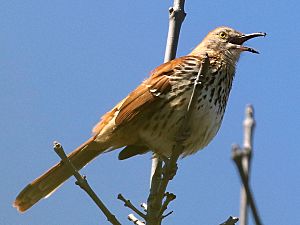
The male brown thrasher might have the largest song collection of any bird in North America. It has been recorded singing over 1,100 different songs! Some experts say each bird can have up to 3,000 song phrases, while others say even more. The male's singing voice is usually more melodic than its relative, the grey catbird. Its song has clear phrases that are repeated no more than three times, but it can sing for minutes at a time. In the fall, the male sings softer, quieter songs. During winter, males might sing short bursts when they have arguments with other males nearby.
When they are young, brown thrashers only make "alarm noises." As adults, they have many different sounds for different situations. Both males and females make "smack" and "teeooo"-like alarm calls when they feel threatened. They make "hijjj" sounds at dawn and dusk. Other calls include a sharp, sudden "chakk," "rrrrr," a "Tcheh" sound that ends with an "eeeur," "kakaka," and sounds like a stick scraping concrete.
Brown thrashers are known for copying other sounds, like other birds (they are in the Mimidae family, after all!). However, they are not as good at mimicking as their relative, the northern mockingbird. But during the breeding season, the male's mimicking skills are at their best. They can copy sounds from tufted titmice, northern cardinals, wood thrushes, northern flickers, and many other birds.
Dangers and Threats
Even though the brown thrasher is common and widespread, its numbers have gone down in some areas. This is mostly because they are losing their natural habitat. However, the decrease is not so bad that the bird is considered a vulnerable species.
One natural problem for them is the parasitic brown-headed cowbird. Cowbirds lay their eggs in other birds' nests. But brown thrashers usually get rid of the cowbirds' eggs. Sometimes, though, thrashers accidentally throw out their own eggs instead of the cowbird eggs because they are similar in size. There was even one time a thrasher raised a cowbird chick!
Northern cardinals and grey catbirds are also big competitors for thrashers when it comes to territory. Because thrashers are not very aggressive towards these species, they can sometimes be driven out of good areas. Brown thrashers often have two groups of young in a year, or their first nesting attempts fail because of predators. Grey catbirds have even been seen invading brown thrasher nests and breaking their eggs.
Besides the catbird, snakes, birds of prey, and cats are some of the main predators of the thrasher. In Kansas, at least eight types of snakes were found to cause nest failures. Birds that hunt adult thrashers include Cooper's hawks, northern goshawks, broad-winged hawks, merlins, peregrine falcons, eastern screech-owls, great horned owls, barred owls, and long-eared owls.
Brown thrashers defend themselves by using their strong beak, which can hurt smaller animals. They also flap their wings and make loud calls.
State Bird of Georgia
The brown thrasher is the state bird of Georgia. The bird also inspired the name of Atlanta's former National Hockey League team, the Atlanta Thrashers.
Images for kids
See also
 In Spanish: Cuitlacoche rojizo para niños
In Spanish: Cuitlacoche rojizo para niños



